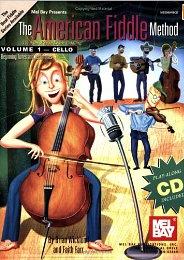I love fiddle music. Maybe it’s the soul of my Scottish and Irish forebears still alive in me. The lively jigs and reels that make you want to dance – or the ballads and airs that make you want to cry – evoke some romantic longing for the old country. That soul came to the new world and lives on in Appalachian and Bluegrass music.
Fiddle music is fun. But it’s not much connected to my instrument of choice, the cello. The cello grew up in the high culture classical music tradition, and was never part of the peasant life that produced the fiddle music I love. Nevertheless, a violin and a fiddle are the same instrument (When you’re buying, it’s a fiddle. When you’re selling, it’s a violin.) and a cello is just a big violin. So you ought to be able to play fiddle music on a cello. An appealing thought, and not an original one as I discovered.
 I bought the Mel Bay American Fiddle Method cello book and gave it a try. First, I found out what a method is. When engineers apply for patents on methods of doing things, they have to explain the method in detail, so someone of “ordinary skill in the art” can duplicate the idea. And the method must be novel – something no one thought of before. None of this applies to a musical method. In the world of music, a method is just a sequence of songs to learn that gradually introduce progressive skills. The sequence is usually embodied in a book, also called a method. The engineer in me was disappointed to find precious little explanation of how to play the cello like a fiddle – that’s up to the student to figure out – though the Mel Bay book includes a CD of all the tunes so you can pick up the style by listening and trying to get the same effect on your instrument. Traditionally, fiddlers didn’t learn from books – they learned by watching and imitating better fiddlers.
I bought the Mel Bay American Fiddle Method cello book and gave it a try. First, I found out what a method is. When engineers apply for patents on methods of doing things, they have to explain the method in detail, so someone of “ordinary skill in the art” can duplicate the idea. And the method must be novel – something no one thought of before. None of this applies to a musical method. In the world of music, a method is just a sequence of songs to learn that gradually introduce progressive skills. The sequence is usually embodied in a book, also called a method. The engineer in me was disappointed to find precious little explanation of how to play the cello like a fiddle – that’s up to the student to figure out – though the Mel Bay book includes a CD of all the tunes so you can pick up the style by listening and trying to get the same effect on your instrument. Traditionally, fiddlers didn’t learn from books – they learned by watching and imitating better fiddlers.
Anyway, the Fiddle Method is a fun change. Most of the tunes are familiar and challenge my sluggish fingers to step lively, like the dancers the old-time fiddlers fiddled for. Fiddle tunes, of course, were composed for violins, and some require real finger stretches on the cello, where the notes are spread out. That’s forced me to learn some phrases in higher positions.
Of course, the pieces are transposed down, usually by an octave, to the cello’s range. The tunes work there, but I miss the edgy fiddle sound. Makes me want to get a cheap Chinese violin…
Ross
October 25, 2010 at 9:42 pm
HI. I am 52 and teaching myself cello. I just found your blog and am enjoying it. This one made me laugh reminding me much of myself and my new-found passion. I inherited this book when I adopted my cello, it came without the cd. I just ordered the Jiji book. I have Essential Elements 2000 and Methode du Jeune Violoncellist by L.R. Feuillard, an etude book. And, of course am learning from the nice people on YouTube. Anyway, I’m having a blast with it and am glad I found your site. Ross
jimmymc
October 26, 2010 at 8:41 am
Thanks! I guess it’s time to write a bit of an update. I’m having so much fun with my little cello these days. I wish you the best of blasts!
ivan schwartz
August 3, 2016 at 10:25 am
It is a great pleasure to return to play cello after almost 50 years ,when i used to do it during 3 years in the high school. Do you think that is it possible af age 67 ? I am lissening to the beutifull recordings of the great cellist of the last 100 years, but this does not offer me what a real g ood teacher may help ,at least at this early stage and old age!
jimmymc
August 3, 2016 at 11:22 am
Ivan,
I’m sure it is possible at 67. It’s a question of how much time and effort you can commit to it, I suppose. Did you read my Never Too Late post?
Jim